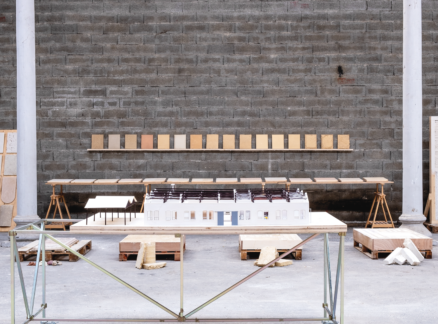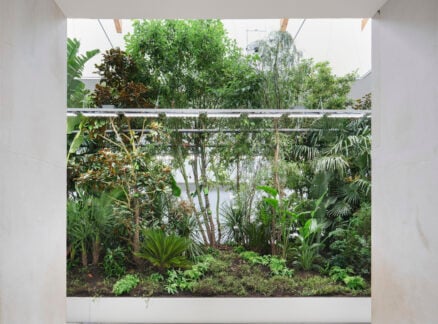
June 23, 2014
Biennale Breakdown: A Guide to the National Pavilions
All the highlights, misses, and surprises from architecture’s biggest event
Architecture, not architects. That was the refrain heard round the Venice Architecture Biennale, which opened on June 5. The words belong, of course, to Rem Koolhaas, architecture’s preeminent theorist, untiring guru of double-speak, and curator of this year’s event.
Two years in the making, Koolhaas’s Fundamentals is a self-styled assault on prevailing architectural culture. Past biennale offerings like David Chipperfield’s 2012 Common Ground directive—a kumbaya congress that impelled architects to “reach across the aisle”—committed the sin of blissful ignorance. That is, they acted like the kids, and architecture, were (mostly) alright. For Koolhaas, however, not only are things not alright, they are rapidly falling to bits.
As the biennale’s main exhibition, “Elements,” illustrates, architecture has become more marginalized than at any point in its history, and architects far less influential in the shaping of the built environment than they’re ready to admit. (A full review of “Elements” is forthcoming in our September issue.) Builders and designers can’t be wholly faulted for the “flattening” of their profession. Rather, it is the global neoliberal hegemony to which architects are necessarily beholden that has bankrupted architecture’s creative and critical faculties.
Globalization’s wayward effects figure in the second-third of the Fundamentals agenda, easily the most fascinating of Koolhaas’s three-pronged framework. (“Monditalia,” the expo’s last component, held at the Arsenale, focuses on contemporary Italy’s sociopolitical and cultural terrain by employing every imaginable artistic medium but architecture. Oh, and there’s interpretive dancing.) “Absorbing Modernity: 1914–2014” surveys the fate of modernity’s global project through the biennale’s 66 national pavilions scattered throughout the Giardini. The strongest of the bunch—the Russian and French exhibitions—explored their modernities through novel, frank, or even witty means. Others, like Brazil’s leaden, poster-board minimalism relied far too heavily on canonical readings of their respective country’s modern histories.
That said, the pavilions present a coherent, nuanced riposte to Koolhaas’s challenge. See the whole breakdown below.
The Highlights
The Misses
The Surprises
The Highlights

© Luc Boegly / Pavillon français pour l’Institut français et le Ministère de la Culture et de la Communication
France
“Modernity, Promise or Menace?”
Along with Albert Speer’s 1938 German Pavilion, France’s schlocky folly may rank as the Giardini’s worst. Small and cramped, the 1911 structure is a cheap Beaux Arts exercise and all-around “mean” building, says Jean-Louis Cohen, the curator of the 2014 French exhibition. The challenge of working with the pavilion, Cohen adds, was almost as great as tackling the biennale brief itself. And yet, the program, which explores France’s interwar commitment to modernity (namely through innovations in beton armé), is slickly contrived and expertly presented.
Right off the bat, the heroic Modernism associated with Le Corbusier’s machine-like villas or the boat-liner expressionism of Robert Mallet-Stevens is flipped on its head. Scenes from Jacques Tati’s Mon Oncle flash on the dark gallery walls, while a large model of the Villa Arpel, the parodic Modernist house that featured heavily in the 1958 film, dominates the foreground. Tati’s satire revels in exposing modern architecture’s fundamental contradictions, an insouciant counterpoint to the “utopian pragmatism” of Jean Prouvé, whose work with standardized building panels is examined in the next room. Prouvé’s metal panels were eventually rendered in rough-cast concrete, the beginnings of a building technology that would, in subsequent decades, be exported to the Soviet bloc and beyond.
But not before being tested out on French soil, as Cohen points out. The exhibit culminates in the final, tragic gallery, which holds a large model of the state-sponsored Cité de la Muette housing project (1935) in Paris-exurb Drancy. The project’s 14-story Modernist “skyscrapers,” designed to house working-class families, were sinisterly converted into a concentration camp during the war to process and hold Jews destined for the gas chamber. Drancy’s remoteness from the city center evidently facilitated the complex’s dire reprogramming, just as, a generation later, segregated urban policies found their outlet in the banlieue. Architecture is never just the problem, but it is always complicit.

Above and below: © Andrea Avezzù, Courtesy la Biennale di Venezia
Russia
“Fair Enough”
“This is so Russian,” said the woman next to me as we entered the pavilion. If, to interpret her emphasis, she meant “tacky,” overstuffed,” and “heterotopic,” then right on all counts! Of course, missing from these epithets is the exhibit’s sharp humor, conspicuously absent elsewhere in the Giardini, but positively brimming here.
Curated by Moscow’s Strelka Institute, the pavilion recreates a trade show floor in miniature, where Russia’s twentieth-century architectural heritage—and not contract furniture by industry mainstays—are displayed in claustrophobic product stalls. “Certified sales representatives” from fanciful companies such as Chernikov Creative Solutions or the Vkhutemas Training School beguile would-be customers with endorsements of, say, avant-garde pedagogy, or in the case of Narkomfin, Ltd., the sustainable joys of collective living.
How, you might ask, is the Soviet housing type of the “social-condenser” viable for the twenty-first century? “Before, when you had top-down planning, Narkomfin didn’t work,” the booth attendant says soberly. “Today’s democratic, bottom-up movements make Narkomfin even more relevant than before.” Quizzical looks all around.
The program, of course, basks in its fair share of cynicism. As a friend put it, history is going nowhere fast, so might as well make a few rubles while you can, right?

Korea
“Crow’s Eye View”
Golden Lion Winner
The single most enjoyable room of the biennale is a small, offshoot gallery in the Korean pavilion, an eclectic show that attempts to grapple with the historic architectural divergences that separate—and in some instances, unite—the two Koreas. The gallery in question is dedicated to the erstwhile memory and uncertain future of the DPRK. Here, plastered on all four walls, are large propaganda reliefs exclaiming the effulgent construction works and state programs of the “glorious” Party. Overseen by North Korea-phile and collector Nick Bonner, this exhibit-within-an-exhibit mixes midcentury linocuts and posters with newer, imaginative works executed by contemporary Pyongyang artists for the touristic promotion of the DPRK’s “utopian” landscape. The overall feeling is more of genuine interest and pride than smug or mocking dismissal.
“I know very little of North Korean architecture,” admits curator Hyungmin Pai, in an essay explaining his intentions behind the exhibit. At the same time, “there are very few in North Korea with any kind of expertise on the architecture of South Korea,” he adds. An attempt to bridge this gap, by seeking out colleagues from the sealed-off North, fizzled out, leaving Hyungmin and commissioner Minsuk Cho to proceed with a more “thematic framework.”
In this vein, the curatorial program maps out the twin modernities pursued by North and South following the war. In the DPRK, where U.S. bombs leveled entire cities, the City Beautiful movement was adopted and adapted according to juche predilection. (In 1991, Kim Jong Il famously published an architectural treatise that elaborated on the “revolutionary” aesthetic precepts of “socialist” building.) To the South, architects like Kim Swoo Geun assisted in the modern redevelopment of urban centers, advancing new models of housing and urban planning that echoed the ambitious projects of the Metabolist movement. On either side of the divide, architecture was wielded as an ideological tool for reconstruction.
Hyungmin concedes that the show’s contents are far from exhaustive, writing that the exhibit “is filled with empty spaces.” Yet, this open-endedness contrasts sharply with the hermetic, encapsulated histories of other pavilions, which, in several cases, merely offer variations on older themes.
The Misses

Above and below: © Andrea Avezzù, Courtesy of la Biennale di Venezia
Brazil
“Modernity as Tradition”
It should have been easy for Brazil, but maybe that was the problem. Perhaps embarrassed by the riches at their command, the curators opted for an understated exhibition—the most straightforward I saw in Venice. The message, relayed exclusively via text and photography, could not have been clearer: “We have been modern for a long, long time.”
The figures of Costa and Niemeyer, Bo Bardi and Burles Marx loom predictably large in the narrative, while bit players like Affonso Reidy show up in the expected capacities as well. The sheer amount of photography dulls, while offering little to nothing new to supplement the standard accounts. Worse, attempts to divine links bridging past and present ring hollow. The Paulista School’s preference for angled concrete planes has very little to do with, say, the swaggering neo-Brutalism of Angelo Bucci’s 2010 Weekend House.

Switzerland
“A Stroll through a Fun Palace”
I’m not sure what I should have expected when I got wind that Hans Ulrich Obrist, pathological interlocutor and curator of the Swiss Pavilion, was planning to “recreate” Cedric Price’s Fun Palace for the biennale. Surely, they weren’t going to erect the thing, not even a sized-down fragment of it. (Also, what did Switzerland have to do with Price?)
As it turns out, Price’s factory for play makes but a guest appearance at the pavilion, where it shares billing with Swiss sociologist Lucius Burckhardt, the little-known progenitor of the “science of strolling.” Obrist explained to Artinfo that, because his archives were only partially digitized, it was necessary “to show with Burckhardt something else.” So Price, long a roguish muse of Koolhaas’s, was seemingly tacked onto the pavilion program at the 11th hour.
The results are unsurprisingly scattered. An original scale model of Fun Palace, complete with LEGO-block seating, appears isolated in a cavernous white gallery. An elderly gentleman carts around a film projector that ostensibly animates the unprepossessing maquette, blowing up its proportions on the backwall. Then the lights cut out, and a pack of overeager architecture students storm the crowd with drawings of Price’s designs, including his Potteries Thinkbelt. They dutifully expound on the significance of these speculative schemes, though the audience is only half-interested—biennale-goers, after all, must fill up time in between parties.

Courtesy Nico Saieh
U.S.
“OfficeUS”
Biennale exhibits typically fall into two camps: classic curatorial programs with various objects and materials carefully posed for observation, and performance-based schemes, which purport to some idea of détournement and as such, involve a good deal of play acting. France falls into the former category, and Russia, the latter. OfficeUS is a problematic mix of the two, though the performative aspect clearly vies for the starring role.
On the one hand, there’s the “repository” or library of building case studies that lines the back walls of the U-shaped pavilion. Each of the chronologically organized binders contain architectural drawings, images, and press clippings of projects executed by international-looking U.S. firms over the last century. If this is archive-building, it’s done in the reverse, with an inordinate focus on the aesthetic whole formed by the materials themselves—historical study as neatly tiled, Tumblr-like accumulation.
Then, there’s the “office” component alluded to in the program’s name. Plastic and silicon office furniture (designed by Leong Leong) does its best to update and one-up OMA’s now tired use of blue-foam while demarcating work zones within the pavilion. It’s here where OfficeUS, a pseudo-firm mobilized exclusively for the biennale, is ostensibly working. Shh!
They weren’t, not during opening weekend at least. Nor was anyone else, however hard the intern-docents encouraged us to join in and fill up the scenery. (I’ve since heard that the desks and computers are more or less regularly in use. But towards what aim? Meanwhile, the entreaties to participatory labor have stopped.) The scheduled workshops sounded dreadfully dull, and the all-day, opening roundtable discussion—where curators Eva Franch i Gilabert, Ana Miljacki, and Ashley Schafer, along with an aimless group of panelists—exegisized for hours on end, was certainly so. This was a performance that outstayed its welcome in the first 30 minutes of its opening. One can only imagine what lows the team’s morale will plumb over the remaining 21 or so weeks until the biennale closes.
At the pavilion’s opening party, held in the courtyard of the Peggy Guggenheim Collection, Franch gave a long-winded speech about OfficeUS’s launch. “I would say that if any revolution consists of bringing large numbers of people together,” she said, “perhaps we’ve started one, if only a little one.” La révolution n’est pas un dîner, nor an architectural biennial, for that matter.
The Surprises

Courtesy Gonzalo Puga
Chile
“Monolith Controversies”
Silver Lion Winner
The Chilean Pavilion was a sleeper hit with visitors. The exhibit is divided in two, with one gallery consisting of an exact replica of an apartment living room belonging to one Mrs. Silvia Gutiérrez, who resides in the city of Viña del Mar. The second gallery displayed a piece of the “panel house” where Mrs. Gutiérrez’s apartment is but one of several plugged-in units. Developments like these, we soon learn, were constructed as part of a giant social housing program promoted by Chilean governments in the 1970s, beginning with socialist President Salvador Allende. The building technology—a version of the much-reviled Plattenbau system used extensively in East Berlin, among other Bloc countries—was a Russian import, which was in turn first developed by French construction specialists. (See France’s pavilion.) Avinash Rajagopal has a more critical write-up of the pavilion here.

Courtesy Nico Saieh
Latvia
“Unwritten”
A crowd favorite, the pavilion intrigued with its leading thesis—what initially appears to be a preposterous claim: “There is no Modernist architecture in Latvia.” Of course, the fun lay in working out what curators No Rules Just Architecture (NRJA) actually meant by this. To do so, you have to walk around the installation, peering at and through the layered paper displays strung taut from the ceiling. This primitive “data cloud” interweaves images and texts (dowload the catalog here) to form a narrative of the country’s postwar modern architecture. In doing so, it shines a critical eye on the received wisdom and optimism of Modernist ideology, hitherto never been fully explored in the context of Latvia’s architectural history, says NRJA.
Of course, there is Modernist architecture in Latvia—that much is certain. Scan the displays and you’ll come across another incontestable truth: “Modernism is dead.”

Albania
“Potential Monuments of Unrealized Futures”
The last show I saw at the biennale, Albania’s pavilion was fittingly sequestered in the furthest corner of the Arsenale. Where most other exhibits piled on the text, photographs, diagrams, and data sets, curator Atelier Albania took a refreshingly sparse approach. The first half of the exhibit consists solely of a handful of paintings by the artist Edi Hila. These lovely canvases, from Hila’s Penthouse series, depict buildings nearly entirely unarticulated, save for their uppermost registers. Disquieting, yet poignant, the paintings monumentalize Albania’s vernacular architecture as a way of “seeing actual buildings as they could be, not as they are,” writes Atelier Albania.
Adjacent to this small gallery is an equally small screening room, where visitors can take in Adrian Paci’s short film, The Column. The sumptuously shot documentary traces the arduous production of a Corinthian column by Chinese laborers, who tend to disappear from view under thick showers of spent marble dust. When completed, the column is seen stowed away in the hull of a shipping frigate, bound for Venice, as it turns out. Making my way out of the Arsenale, I only half stumbled onto the actual column, which is rather unceremoniously parked at the edge of the basin. The scene is appropriately forlorn—a castaway waiting to be found, an element ready for integration.
Recent Viewpoints
Viewpoints
Sustainability News Updates for Q2 2025





